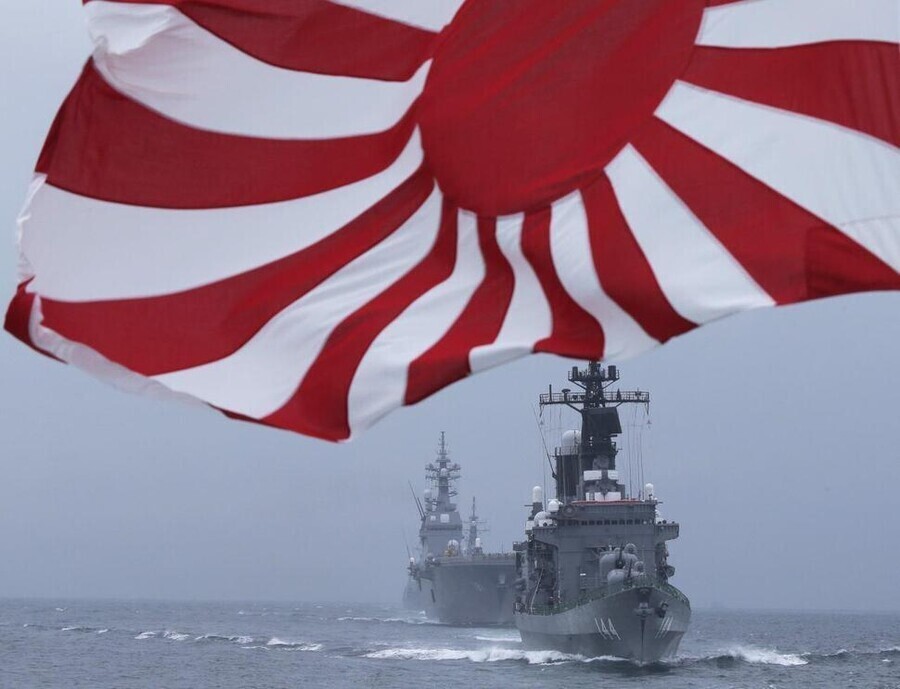hankyoreh
Links to other country sites 다른 나라 사이트 링크
Japan wanted S. Korea to OK flying of ‘rising sun’ flag while resolving radar lock-on dispute

During discussions between the South Korean and Japanese governments Saturday over measures to prevent the reoccurrence of a patrol aircraft radar lock-on dispute that has been hamstringing military cooperation for over five years, the Japanese representatives at the negotiations reportedly asked the South Korean ones for confirmation that the use of the “rising sun” flag by the Japan Self-Defense Forces (JSDF) would not be an issue.
Observers say Japan crossed a line by asking South Korea to agree to the official use of a flag that South Koreans react quite sensitively to, regarding it as a symbol of the war of aggression waged by Japanese imperialists in the past.
In a report Sunday on the patrol aircraft issue, the Yomiuri Shimbun newspaper said that the rising sun flag issue had emerged as a “point of contention” in the final stages of South Korea-Japan negotiations, explaining that the Japanese side had “sought to draw confirmation from South Korea that there would be no problem” with the flag being flown.
The report went on to say that the “South Koreans hardened their attitude, saying that they would be willing to forgo the agreement” on the patrol aircraft issue and that Japan “conceded” by not including items related to the flying of the flag in the agreement.
The reason Tokyo felt empowered to demand that the Yoon Suk-yeol administration agree to its military using the flag — even in the face of a likely strong backlash in South Korea — was likely because of a recent shift in the two sides’ relationship.
Despite widespread opposition from the South Korean public, Yoon has made unilateral concessions in the past on issues such as compensation to victims of forced labor. After seeing this response to matters that had been a source of grief, the Japanese government appears to be looking to take advantage of the situation to resolve some of these long-simmering issues.
Another factor was the Yoon administration’s acceptance of Japan’s use of the rising sun flag within South Korean territory in the interest of expanding bilateral military cooperation — a break with the policies of predecessor Moon Jae-in.
In May 2023, a Japan Maritime Self-Defense Force escort ship flew the flag as it entered the port of Busan to take part in Eastern Endeavor 2023, a multinational maritime interception drill held in South Korea.
Citing this example from May of last year, the Yomiuri Shimbun wrote that the Yoon administration had allowed the flying of the flag at the time, suggesting that the Japanese side came to the conclusion that South Korea had already judged there to be no problem with the ensign.
In October 2018, the Moon administration asked a Japanese warship scheduled to take part in an international naval review in Jeju to refrain from flying the rising sun flag. Japan responded by raising strong objections and pulling out of the event.
South Korea has repeatedly called on Japan to refrain from its use of the flag, calling it a symbol of Japanese imperial invasion and war crimes, but Japan maintains that it is a national symbol. Only on rare and exceptional occasions, once during the Kim Dae-jung administration in 1998 and again under Lee Myung-bak in 2008, did the Japanese maritime forces take part in international fleet reviews hosted by the South Korean Navy.
The rising sun flag was adopted as the official ensign of Japan’s ground forces in May of 1870. It measures 134.2 centimeters across and 152.5 centimeters tall, depicting the sun with a red circle at its center, known as the “hinomaru.” From this red circle, 16 lines radiate outward toward the edges, symbolizing the rays of the sun. The flag selected to be the official naval ensign of Japan’s maritime forces in 1899 depicts the red circle slightly off-center, a divergence from the flag used by ground forces.
In 1954, Japan established the Japan Self-Defense Forces, and the former naval ensign was selected to become the flag of the new armed forces in an enforcement decree accompanying the Self-Defense Forces Act. Pursuant to the act, vessels belonging to the JSDF, including warships, must fly the flag alongside the Japanese flag.
By Kim So-youn, Tokyo correspondent
Please direct questions or comments to [english@hani.co.kr]

Editorial・opinion
![[Column] Is Korean democracy really regressing? [Column] Is Korean democracy really regressing?](https://flexible.img.hani.co.kr/flexible/normal/500/300/imgdb/original/2024/0705/2917201664129137.jpg) [Column] Is Korean democracy really regressing?
[Column] Is Korean democracy really regressing?![[Column] How tragedy pervades weak links in Korean labor [Column] How tragedy pervades weak links in Korean labor](https://flexible.img.hani.co.kr/flexible/normal/500/300/imgdb/original/2024/0703/8717199957128458.jpg) [Column] How tragedy pervades weak links in Korean labor
[Column] How tragedy pervades weak links in Korean labor- [Column] How opposing war became a far-right policy
- [Editorial] Korea needs to adjust diplomatic course in preparation for a Trump comeback
- [Editorial] Silence won’t save Yoon
- [Column] The miscalculations that started the Korean War mustn’t be repeated
- [Correspondent’s column] China-Europe relations tested once more by EV war
- [Correspondent’s column] Who really created the new ‘axis of evil’?
- [Editorial] Exploiting foreign domestic workers won’t solve Korea’s birth rate problem
- [Column] Kim and Putin’s new world order
Most viewed articles
- 1[Column] Is Korean democracy really regressing?
- 2Real-life heroes of “A Taxi Driver” pass away without having reunited
- 3What will a super-weak yen mean for the Korean economy?
- 4Beleaguered economy could stymie Japan’s efforts to buoy the yen
- 5South Koreans living near border with North unnerved by return of artillery thunder
- 6Car behind deadly crash began rapid acceleration after exiting underground garage
- 7Shoddy records help Korean hospitals conceal abuse of mentally ill
- 8[Column] How tragedy pervades weak links in Korean labor
- 9Experts cast doubt on driver’s claim that sudden unintended acceleration caused deadly crash
- 10In the blink of an eye, an unthinkable crash turned a night out into a nightmare